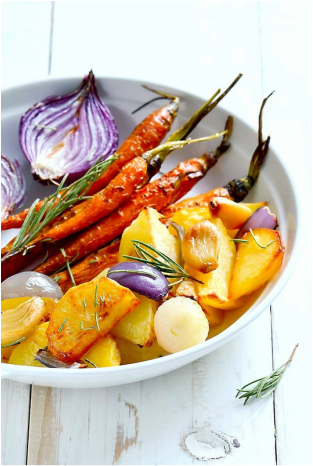|
Post 3 of Series "Better Health frough Better Eating From the Bounty Box" by Mi Ae Lipe, author of Bounty from the Box; The CSA Farm Cookbook. More Information: /blog-author---mi-ae-lipe.html [Photo caption: Jack Hedin, owner of Featherstone Farm in southeastern Minnesota, checking on carrots in the field. Photo courtesy of Featherstone Farm.] This essay is written by Jack Hedin, owner of Featherstone Farm, one of the largest organic vegetable farms in southeastern Minnesota. As consumers of supermarket produce, we have grown accustomed to eating pretty much any vegetable or fruit all year-round, rather than waiting for certain crops to come into season. This concept of eating something in season and what this means to me as a farmer—pulling leaves off broccoli, eating green beans at different times of the year, harvesting the perfect radish—grows increasingly important as the years pass. To me, seasonality is not just when something is available, but when it is good, and dependably so. Weather, climate, and soil conditions enormously impact the quality of both fruits and vegetables. We humans tend to perceive the seasons as how we experience weather when we are out and about (always during the day). Plants, on the other hand, experience seasons as night and day: dew sets that occur because of humidity, moisture, wind (or the lack of them), and temperatures. In particular, here in southeast Minnesota, temperature differences during the day and night can range in June from 45 degrees Fahrenheit at night to 86 degrees during the day. In August, that nighttime temperature might not get below 70 degrees. Moisture in the field and how soil and its organic matter retains moisture in the root zone are also extremely important factors. Dewfalls play critical roles too. Every single morning in August, the fields will be completely soaked. When the sun rises, even if it is brightly shining, its solar energy goes first into drying things out, not into the leaves to make energy, Such fluctuations really affect how a melon ripens in the field, for instance. Squash and melons need accumulated heat to ripen. That means that they do not start to ripen until all of their leaves are dry, so those dewfalls in the valley hugely impact how these crops develop. Having worked on farms in California, I often think in terms of the conditions of where a crop is grown in that agricultural state, where so many different microenvironments exist. Here in our valley in southeastern Minnesota, the nightly dew sets mimic the coastal fogs of California’s heavily cultivated Salinas Valley, which is why we grow so much leaf lettuce and broccoli. Both prefer cool soils and plenty of moisture. One of the most striking examples of the divide between the consumer perception of seasonality and actual seasonality occurs with radishes. When we come to the farmers market in June, everyone lines up to get radishes because they are psyched up for it. [Photo by Baloncici, Dreamstime.com] What is happening in the field, however, is that the lengthening days are causing the radishes to grow so fast in May and June that they get pithy and hollow inside. When the soil reaches above 65 degrees, the roots lose crunch, juiciness, and sweetness, and turn very spicy. What people perceive as peak radish time in early June is, in my mind, a pretty risky season. Although radishes can be good at this time, what I believe people are really responding to is the lack of fresh fruits and vegetables during the previous six or eight months. They are not necessarily looking for radishes; they are seeking something good, and even though these radishes might be fresher than those from California, they are nothing like the fall radishes we harvest. In September and October, the radishes are growing so much more slowly. The nights are cooler, and we get unbelievably good radishes at this time of year; they are what I think of as an in-season radish. But this timing is so contrary to what most people think about radishes. The same is true for lettuce. Our initial goal was to cultivate all of the leaf lettuce one could eat during the entire growing season, which runs from May 20 to November 1. But the lettuce is superb for only a short time, between May 20 and June 20. After that, we do not grow lettuce in July and August, for it quickly turns bitter once the soil becomes hot and dry. Yet another example of seasonality occurs with broccoli. Because of our scale, we do not want to grow many acres of a certain crop until we know it will have a high success rate. In the case of broccoli, we need 80 to 90 percent of our crop to have both high eating quality and be aesthetically superior. Here in southeastern Minnesota, it is possible to harvest broccoli every day from June 20 to November 10. But broccoli loves cool weather and even frost; if the temperatures are not falling below 30 degrees at night, it won’t be as sweet. As a result, our broccoli is best only about eight to ten weeks of that time, from about September 10 to October 20. Broccoli could be in every CSA basket during the summer and fall, but in times of hot days, warm nights, and dry soil, it will be stringy and tough. If it looks any good at all, the heads are likely to be bitter. Even though we could sell and market it, this poorer-quality vegetable is not what we want to promote as a grower. ______________________________________ [Photo by fortyforks, Dreamstime.com] Roasted Root Vegetables from Greta’s Kitchen
Serves 6 In the dead of winter in much of the country, it can be a little hard to get a good, crisp, sweet radish grown locally. But this recipe uses daikon, a type of Japanese radish that has a longer, more year-round season (in fact, it is sometimes grown as a winter cover crop). If you can’t find daikons, no need to worry—this hearty dish is delicious with any sort of root vegetable in season. This recipe is courtesy of Greta Sikorski of Featherstone Farm in Rushford, Minnesota. Note: Bragg Liquid Aminos is a liquid protein formula derived from soybeans; it makes a great savory seasoning alternative to soy sauce, which contains gluten. To make a totally gluten-free gravy, substitute potato starch for the regular wheat flour, and use Bragg instead of soy sauce. 3 pounds various root vegetables, including carrots, potatoes, beets, rutabaga, turnips, parsnips, celeriac, and daikon radish, peeled and chopped into ½-inch cubes 2 tablespoons olive oil 2 tablespoons soy sauce or Bragg Liquid Aminos 2 tablespoons maple syrup Salt and freshly ground black pepper Fresh or dried thyme, to taste (optional) Grated ginger, to taste (optional)
— Recipe by Greta Sikorski of Featherstone Farm, Rushford, Minnesota, from Bounty from the Box: The CSA Farm Cookbook
2 Comments
Kate Olson
3/3/2016 01:41:32 am
Trying some of these great recipes. I will definitely be checking out CSA. Thanks
Reply
Leave a Reply. |
Blog By Kate Olson Kate is a Hypnotherapist, NLP Practitioner & Trainer, Reiki Master, Energy Healer, Life Coach and more. To find out more about her or her work, click the links below:
Get Kate's Book & Journal!
Living in Joyful Resilience: A Roadmap for Navigating Life's Ups & Downs & Simple Soul Thoughts : Collecting Moments of Joy www.joyfulkate.com About the Blog After 4 years of featuring at least 1 guest Author a month this blog changed in 2020. I loved featuring the posts of other great people who also believe in mind, body, spirit wellness. I will continue to feature articles submitted to me on this topic that align with my own mission. However, finding & reaching out to others is time consuming and I do it for my radio show, Soul Talks and other groups and projects and so for this blog i will be ramping up my own posts and perspective. posting mostly my own blogs. I will be happy & excited to post articles from those who submit them to me. Archives
April 2022
Categories |
Proudly powered by Weebly







 RSS Feed
RSS Feed